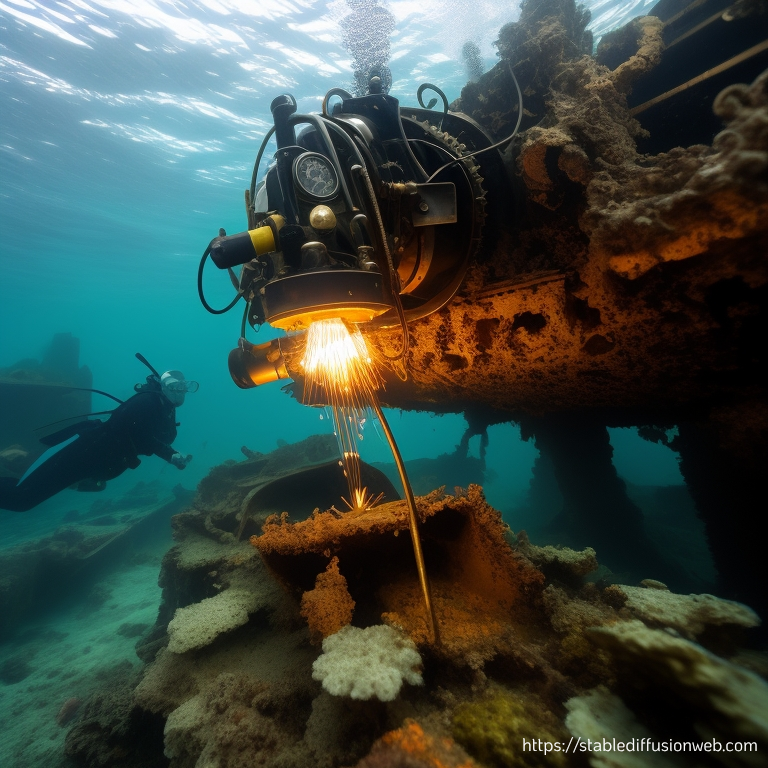Naval Salvage Operational AI Use Cases

Being an Advanced Certified SCUBA Diver, I have long been intrigued with what it might look like to make a career out of diving, including the complexities of Technical Diving.
Fueled by adventures laid out in books such as books such as Deep Descent which offers only a small taste into what technical diving looks like.
When it comes to industry, we see needs for technical divers in Oil and Gas exploration, Telecommunications, and things like Naval Salvage.
Curious about the applications of Artificial Intelligence, in the domain of Naval Salvage (an industry which admittedly, I have more than a passing interest, but nothing approaching insider expertise), I took to ChatGPT to help me understand some possible AI Use Cases for Naval Salvage.
There are few things more dangerous in terms of risk than the industries that require human divers to go very deep. Deep technical diving requires breathing a mix of different gasses, because at extreme depths breathing simple oxygen becomes poisonous. See Mixed Gas Diving. Such operations require considerable top side surface support vessels and teams of relief divers, rescue divers, dive support surgeons, decompression chambers and other very advanced equipment and experts.
As with any new technology, AI Predictive Analysis, Generative AI, or AI Image Recognition all offer promising assistance to humans in complex and risky laden industries.
So let’s conduct a thought exercise on AI, and it’s potential uses in the industry of Naval Salvage, which we have established is fraught with risk, and may lie right up there with space exploration in terms of required technology, human support systems, and in-hospitable environment that would ruthlessly crush inferior objects.
When I asked ChatGPT to provide me with possible AI use cases for the Naval Salvage industry, this is what it provided:
“AI Underwater Exploration and Mapping”,
“AI Shipwreck Identification”,
“AI Salvage Operation Planning”,
“Environmental Impact Assessment”,
“Diving Safety and Risk Mitigation”
Ok, so with just 5 potential use cases, we already have a lot going on. Let’s try to discover which one of these use cases is a good idea for applying AI and which are not, shall we?
“Underwater Exploration and Mapping” – I think this sounds like a generally good use case for AI Computer Vision. Computer vision AI compared with the correct types of optics, and perhaps lasers for measuring distance, or sonar for measuring distance may in fact greatly assist in providing detailed mappings of the seafloor and detecting things like ship wrecks, plane wrecks, or measuring ocean reefs. In the high risk world of Naval Salvage, this AI Use Case appears at face value to be fairly low risk within that context, and this is by no means a full risk assessment, but rather an idea of how such a risk assessment should be approached.
Up Next, We have the idea of using AI Shipwreck Identification, I think this is an extremely useful purpose for Computer Vision AI to assist in detecting features of missing shipwrecks, perhaps some technology such as this, and including underwater drones, we can AI find the missing Malaysia Airlines Flight 370 – MH370 or other missing vessels both famous and unknown.
Next we have AI Enabled Salvage Operation and Planning – Red Alert here, ok maybe Yellow Alert, it’s time to pay attention. The operation and planning phase of salvage are in the direct path of human safety.
That is to say that human safety depends on correct salvage operations and planning, from this point forward, let’s be careful that AI is into introduced into any role that is critically adjacent to human safety.
Let’s also ensure that human safety has not made in any way a dependency on any underlying AI technology. We need humans in the loop at that layer, and it needs concentric rings of safety around critical operations.
Now, let’s imagine the use case of AI Environmental Impact Assessment, here there might be some justifiable use cases that may require less human intervention, provided that AI behavior is predictable and remains that way. So now we have AI in charge of Environmental Impact, great, AI can replace the EPA, can it possibly be more efficient and more accurate an assessing Environmental Impact? How about this, will some form of data analysis correct biased assumptions in climate models that are putting undue regulatory requirements on humans and industries? Will AI serve to fix that or make it worse? It remains to be seen?
Would we have built offshore Wind Turbines if AI uncovered that such construction projects would harm ocean species and if those efforts were causing an increase in beached whale injuries and deaths?
Finally, we have Diving Safety and Risk Mitigation. Here is where we have to initially hit the brakes full stop because the idea to introduce AI adjacent to human safety means that a well orchestrated concentric and fail safe approach must be built into this process. This requires a full blown analysis and a narrow restriction on which AI behaviors are allowed, as well as emergency response being pre-planned and well contemplated before beginning.
In an environment where AI is in the critical path of safety, humans in the loop (AI First Responders) need to be tasked, trained and drilled on decisive intervention in the case of an AI failure. Or else lives will be lost.
